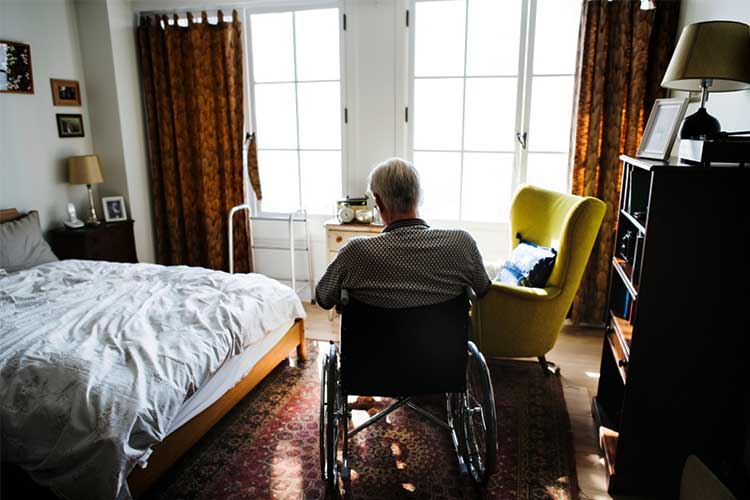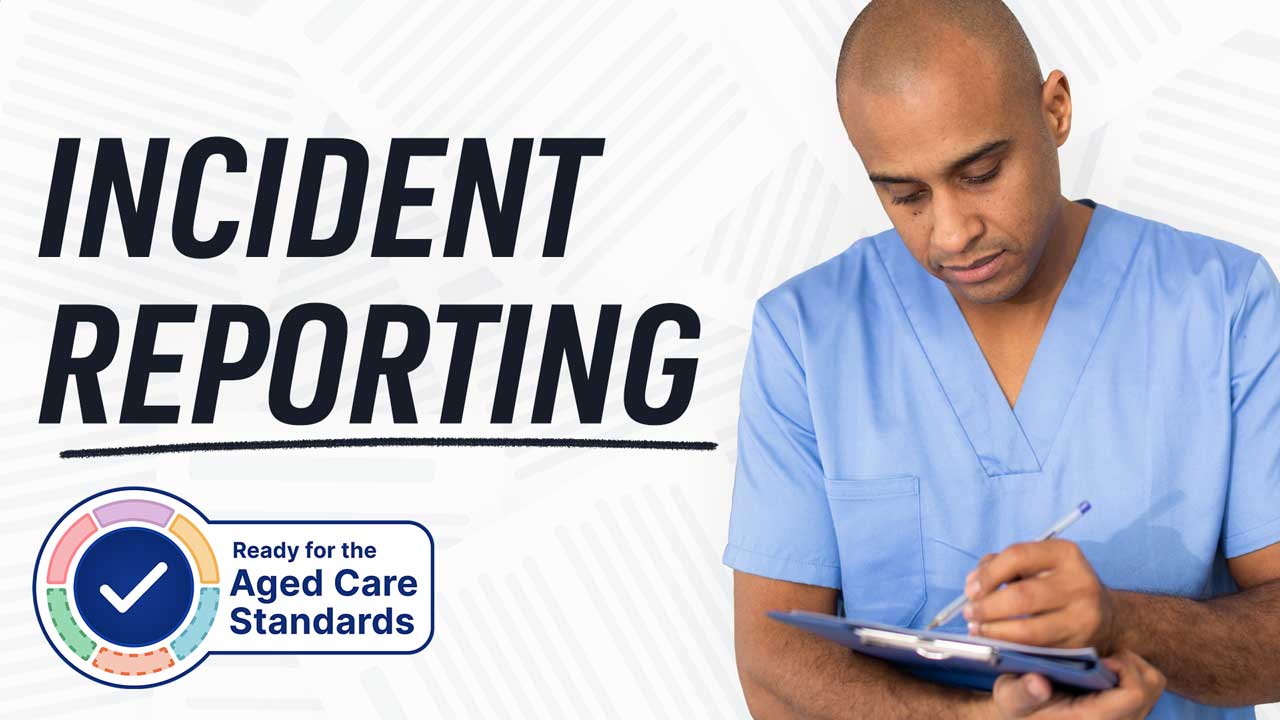Incident reporting is the responsibility of all staff working in healthcare facilities.
Knowing how to fill out an incident report is necessary knowledge for any professional. An incident report should be completed immediately after an incident has occurred and appropriate corrective action followed.
Incident reports are integral to a functional healthcare system that is committed to ongoing improvement and transparency.
The following is intended as a general guide to filling out an incident report. Your organisation may have certain criteria involved in completing an incident report, and it is advised that you make yourself aware of the appropriate policies specific to your facility.
Incident reporting relates to the following Australian healthcare standards:
- Strengthened Aged Care Quality Care Standards - Standard 2: The Organisation - Outcome 2.5: Incident Management
- National Safety and Quality Health Service Standards - Standard 1: Clinical Governance - Action 1.11: Incident Management Systems and Open Disclosure
- NDIS Practice Standards - Core Module 2. Provider Governance and Operational Management - Incident Management and Verification Module - Incident Management.
What is an Incident?
An incident is anything that happens out of the ordinary in a facility - specifically, unplanned events or situations that result in, or have the potential to result in, injury, ill health, damage or loss (WorkSafe Tasmania 2022).
Examples of an Incident in Healthcare:
- An aged care resident slips and falls on their way to the bathroom.
- A patient is accidentally dispensed a medication prescribed for another person.
Types of Incidents
Clinical Incidents
The Australian Commission on Safety and Quality in Health Care (2021) defines a clinical incident as ‘an event or circumstance that resulted, or could have resulted, in’:
- Unintended or unnecessary harm to a patient or consumer
- A complaint, loss or damage, and/or
- A near miss.
This may include an omission of care that would have likely benefited the patient or consumer (ACSQHC 2021).
Clinical incidents could involve:
- Communication-related incidents
- Diagnosis-related incidents
- Falls and other injuries
- Medication errors
- Treatment issues
- Healthcare-associated infection
- Privacy breaches.
(Hooiveld 2024; Australian Digital Health Agency 2024)

Sentinel Events
Sentinel events are a subtype of clinical incidents that are considered the most serious incidents. They are entirely preventable incidents that result in serious harm to or death of a patient (ACSQHC 2020).
There are 10 nationally recognised sentinel events in Australia. They are:
- Surgery or other invasive procedure performed on the wrong site resulting in serious harm or death
- Surgery or other invasive procedure performed on the wrong patient resulting in serious harm or death
- Wrong surgical or other invasive procedure performed on a patient resulting in serious harm or death
- Unintended retention of a foreign object in a patient after surgery or other invasive procedure resulting in serious harm or death
- Haemolytic blood transfusion reaction resulting from ABO incompatibility resulting in serious harm or death
- Suspected suicide of a patient within an acute psychiatric/unit or acute psychiatric ward
- Medication error resulting in serious harm or death
- Use of physical or mechanical restraint resulting in serious harm or death
- Discharge or release of a child to an unauthorised person
- Use of an incorrectly positioned oro- or naso-gastric tube resulting in serious harm or death.
(ACSQHC 2020)
Non-clinical Incidents
Non-clinical incidents could involve:
- Bullying
- Hazards being identified
- Injury to a staff member
- Injury to students or visitors
- Professional misconduct
- Property issues
- Security issues or breaches
- Vehicle accidents.
(Benalla Health 2011)
Take into consideration the above examples as well as other issues as outlined by your organisation.
What are Your Responsibilities?
Sentinel Events
Healthcare services must report all sentinel events that occur via their state or territory’s incident reporting system (ACSQHC 2024).
Reportable Incidents in Aged Care
Standard 2: The Organisation - Outcome 2.5: Incident Management of the strengthened Aged Care Quality Standards (Action 2.5.4) requires aged care providers to support their staff to report incidents that occur (ACQSC 2024).
Additionally, Action 2.5.3 requires providers to support older people and their families and carers to report incidents (ACQSC 2024).
Providers should have processes in place outlining the following:
- Who is responsible for reporting incidents
- How an incident should be documented
- The required amount of detail for incident reports
- How to submit incident reports
- When to submit incident reports.
(ACQSC 2024)
The Serious Incident Response Scheme
Under the Serious Incident Response Scheme (SIRS) introduced in 2021, aged care providers are required to report eight types of incidents to the Aged Care Quality and Safety Commission:
- Unreasonable use of force
- Unlawful sexual contact or inappropriate sexual conduct
- Neglect
- Psychological or emotional abuse
- Unexpected death
- Stealing or financial coercion by a staff member
- Inappropriate use of restrictive practices
- Unexplained absence from care.
(ACQSC 2022)
For more information on the SIRS, see Ausmed’s Training Module: Serious Incident Response Scheme (SIRS).
Immediate Actions to Take Following an Incident
Once an incident has been identified, you must:
- Ensure the safety of the affected person(s)
- Provide immediate care to the affected person(s) and ensure all necessary steps have been taken to support and treat them
- Make the situation safe
- Notify your manager and the medical team as necessary
- Notify security and the police if necessary
- Remove or address any malfunctioning equipment or supplies
- Document information about the events leading to the incident
- Commence open disclosure procedures.
(ACSQHC 2021)
Once the situation has been made safe, the incident must be documented and reported (ACSQHC 2021).
How to Write An Incident Report

An incident report requires questions relevant to who, what, when, where, how and why to be completed (Safe Work Australia 2015).
Who
- The name and contact details of the person reporting the incident
- The name and details of the person(s) affected.
What
- What occurred
- Type of incident (e.g. death, serious injury, illness)
- In-depth description of the incident
- What initial actions did you take?
- Incident severity rating.
When
- When did the incident occur? (date and time).
Where
- Where did the incident occur?
How and why
- How and why did the incident occur?
- What were the contributing factors (i.e. events surrounding the incident)?
(Safe Work Australia 2015; Health.vic 2011)
Considerations for Completing a Report
- Use concise, objective language (void of opinion)
- Be as specific as possible
- Write what was witnessed and avoid assigning blame or making assumptions about what occurred
- Avoid abbreviations
- De-identify information where appropriate
- Report the incident within the required timeline (refer to relevant legislation and standards and your organisation's policies and procedures).
(ACSQHC 2021; Health.vic 2011)
Who can Submit an Incident Report?
Any staff member who witnesses an incident has the responsibility to report it. Visitors, community members, students, contractors, patients/clients/residents and volunteers may also witness incidents and will need to communicate this to the nominated person within the organisation they are in.
Local policies and procedures will guide who makes the actual written submission using your organisation’s risk management tool or software.
Is There a Broader Purpose for an Incident Report?
An incident report not only has the potential to shed light on a particular incident but may reveal room for improvement in systems, procedures and environments.

Test Your Knowledge
Question 1 of 3
Which one of the following is a non-clinical reportable incident?
Topics
Further your knowledge
References
- Aged Care Quality and Safety Commission 2024, Standard 2: The Organisation, Australian Government, viewed 17 April 2024, https://www.health.gov.au/resources/publications/strengthened-aged-care-quality-standards-august-2025?language=en
- Aged Care Quality and Safety Commission 2022, SIRS in Residential and Home Services, Australian Government, viewed 17 April 2024, https://www.agedcarequality.gov.au/for-providers/serious-incident-response-scheme/sirs-residential-home-services
- Australian Commission on Safety and Quality in Health Care 2020, Australian Sentinel Events List (Version 2) Specifications, Australian Government, viewed 17 April 2024, https://www.safetyandquality.gov.au/publications-and-resources/resource-library/australian-sentinel-events-list-version-2-specifications
- Australian Commission on Safety and Quality in Health Care 2021, Incident Management Guide, Australian Government, viewed 17 April 2024, https://www.safetyandquality.gov.au/publications-and-resources/resource-library/incident-management-guide
- Australian Commission on Safety and Quality in Health Care 2024, Incident Management and Sentinel Events, Australian Government, viewed 17 April 2024, https://www.safetyandquality.gov.au/our-work/indicators-measurement-and-reporting/incident-management-and-sentinel-events
- Australian Digital Health Agency 2024, Clinical Incidents, Australian Government, viewed 17 April 2024, https://www.digitalhealth.gov.au/healthcare-providers/initiatives-and-programs/my-health-record/clinical-incidents
- Benalla Health 2011, Incident Reporting Procedure, Benalla Health, viewed 17 April 2024, https://www.benallahealth.org.au/userfiles/files/VHIMSIncidentReportProcedure.pdf
- Health.vic 2011, A Guide to Completing Incident Reports, Victoria State Government, viewed 17 April 2024, https://www.safercare.vic.gov.au/sites/default/files/2018-03/incidentreportwriting%20-%20PDF.pdf
- Hooiveld, J 2024, What Type of Incidents Take Place in Healthcare, The Patient Safety Company, viewed 17 April 2024, https://www.patientsafety.com/en/blog/type-of-incidents-in-healthcare
- Safe Work Australia 2015, Incident Notification Information Sheet, Australian Government, viewed 17 April 2024, https://www.safeworkaustralia.gov.au/doc/incident-notification-information-sheet
- WorkSafe Tasmania 2022, How to Run an Effective Incident Investigation, Tasmanian Government, viewed 17 April 2024, https://worksafe.tas.gov.au/advisoryservice/read-our-advisors-magazine-columns/how-to-run-an-effective-incident-investigation
 New
New 

